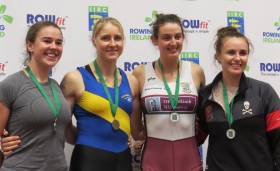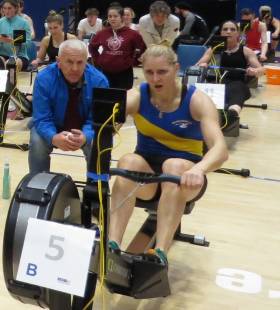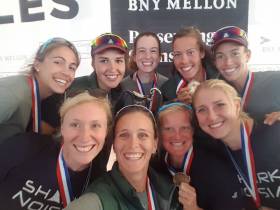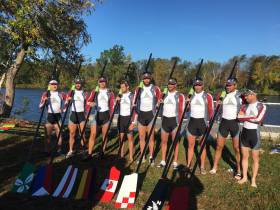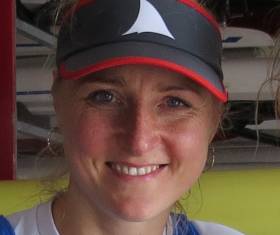Displaying items by tag: Sanita Puspure
Skibbereen Sunday in Doubt on Bumper Weekend for Irish Rowers
#Rowing: This weekend is one of the busiest of the year for Irish rowers. At the National Rowing Centre in Cork the University Championships of Ireland will be held on Friday, April 13th, and Skibbereen Grand League Regatta is scheduled for Saturday and Sunday, April 14th and 15th. This event has its biggest-ever entry, but a very bad weather forecast for the Sunday has put competition on that day in doubt. Three Ireland women’s crews will also compete in an international regatta in Italy, the Memorial Paolo d’Aloja in Piediluco.
World champions Mark O’Donovan and Shane O’Driscoll and Olympic medallists Paul O’Donovan and Gary O’Donovan arrived home earlier this week after three months training and competition in New Zealand and Australia. The four Skibbereen men intend to compete in their home club’s regatta.
On Friday, over 140 crews from 10 different universities and colleges around the country will compete in the University Championships. The event is set to start at 9:30 am with a straight final of the senior men’s fours and races will run throughout the day. The final contest, the men’s senior eights is scheduled for 4:20 pm.
In Italy, two-time Olympian Sanita Puspure will compete in the heavyweight women’s single sculls in Piediluco. Aileen Crowley and Monika Dukarska will race in a double scull, while Emily Hegarty and Aifric Keogh are set to compete in a pair.
Puspure Honoured as Women Produce Good Results
#Rowing: The Afloat Rower of the Month for January is Sanita Puspure. The Old Collegians competitor produced a creditable time of six minutes 39.8 seconds for 2,000 metres at the Irish Indoor Rowing Championships. Sam McKeown beat his own time to set a new record of 5:53.0 and lead the men’s rankings, while Puspure headed up a good set of performances by women. Aileen Crowley, Emily Hegarty, Aifric Keogh and Fiona Murtagh all recorded figures under seven minutes.
Rower of the Month awards: The judging panel is made up of Liam Gorman, rowing correspondent of The Irish Times and David O'Brien, Editor of Afloat magazine. Monthly awards for achievements during the year will appear on afloat.ie. Keep an eye on progress and watch our 2018 champions list grow.
McKeown and Puspure Best at Irish Indoor Rowing Championships
#Rowing: Sam McKeown set a new Irish record of five minutes 53 seconds at the Irish Indoor Rowing Championships at the University of Limerick today. The Queen’s University man was the only competitor to breach the six-minute mark.
In the women’s competition, Sanita Puspure ruled. Her time of 6:39.8 was not her best, but she had almost 12 seconds to spare over Aileen Crowley, who was hitting a new personal mark. Emily Hegarty won the women’s under-23 section and Conor Egan the men’s.
Denise Walsh was the best lightweight woman on the day, while Aoife Hegarty the best under-23 lightweight. Aodhan Burns topped the men’s open lightweight ranks, which were very spare, while Jake McCarthy bettered his twin, Fintan, in the men’s under-23 lightweight competition.
The best juniors were Alex Byrne of Shandon and Zoe McCutcheon of Enniskillen.
Irish Indoor Rowing Championships, University of Limerick, Saturday (Selected Results)
Men
Open: S McKeown 5:53.0. Under-23: C Egan 6:08.1. Jun 18: A Byrne 6:15.0. Jun 16: A Sheehan 6:47.3.
Lightweight Open: A Burns 6:29.9. Lightweight Under-23: J McCarthy 6:22.2.
Women
Open: S Puspure 6:39.8. Under-23: E Hegarty 6:56.7. Jun 18: Z McCutcheon 7:19.7. Jun 16: M Curry 7:21.0
Lightweight Open: D Walsh 7:13.4. Lightweight Under-23: A Casey 7:18.1.
Ireland's Great Eight Pair are Rowers of the Month
Paul O'Donovan in Great Eight of World Scullers
#Rowing: Paul O’Donovan, the lightweight single sculls world champion, ended his season on a high as he rowed in the Great8 of top scullers which took second at the Head of the Charles River in Boston. The University of California won in a record time. O’Donovan was the bowman and is seen in this picture on the left. The crew finished second, inside the old record.
Sanita Puspure was a key part of the women’s Great8 which won, and set a new record. Course specialist Genevra Stone stroked the crew having subbed into the boat for Magdalena Lobnig, who was ill.
Puspure Just Outside Medal Pace at World Rowing
#Rowing: Sanita Puspure finished fourth in the A Final of the women’s single sculls at the World Rowing Championships in Sarasota-Bradenton in Florida.
Switzerland’s Jeannine Gmelin prospered in the difficult conditions, taking gold ahead of Victoria Thornley of Britain. Austria’s Magdalena Lobnig held off a late sprint by Puspure to take bronze. Puspure was just .35 of a second behind.
The lanes had been redrawn because of wind, placing Puspure in lane four. She had been drawn in two, but the higher-numbered lanes were thought to have an advantage. Lobnig, who has shown herself to be a good performer in choppy water, survived a wobble in the middle of the race when her oar did not make proper contact with the water.
World Rowing Championships– Irish interest
Women
Single Sculls – A Final: 1 Switzerland (J Gmelin) 7:22.58, 2 Britain (V Thornley) 7:24.50, 3 Austria (M Lobnig) 7:26.56; 4 Ireland (S Puspure) 7:26.91, 5 Netherlands 7:32.69, 6 Canada 7:35.93.
Gutsy Performance Secures A Final For Puspure at World Rowing
#Rowing: Sanita Puspure secured an A Final spot at the World Rowing Championships today. The Old Collegians sculler took a close-up second in her semi-final of the single sculls. Puspure produced an intelligent, gutsy performance. In a tight contest she moved at halfway to secure a place in the top three; after the 1500 metres mark she charged again, and was just three-hundredths of a second behind Jeannine Gmelin of Switzerland, who qualified in first. Behind them, Magdalena Lobnig of Austria just ousted Felice Mueller of the US for third.
World Rowing Championships, Sarasota-Bradenton, Day Six – Irish interest:
Women
Single Sculls – Semi-Final Two (First Three to A Final; rest to B Final): 1 Switzerland (J Gmelin) 7:26.90, 2 Ireland (S Puspure) 7:26.93, 3 Austria (M Lobnig) 7:27.79; United States (F Mueller) 7:27.89.
Semi-Final One: 1 Britain (V Thornley) 7:31.72, 2 Netherlands (L Scheenard) 7:34.09, 3 Canada (C Zeeman) 7:34.33.
Puspure Takes Third in B Final at Lucerne Rowing
#Rowing: Sanita Puspure took third in the B Final of the women’s single sculls at the World Cup Regatta in Lucerne, ninth overall, while Monika Dukarska was three places further back, in sixth (12th overall). Puspure was part of a five-boat sprint finish, and she showed good speed to finish ahead of Fie-Udby Erichsen of Denmark and Ekaterina Karsten of Belarus. Ahead of her was winner Diana Dymchenko of Ukraine and Hannah Osborne of New Zealand. Dukarska, who had started well, had fallen a few lengths off this leading group by the finish.
World Cup Regatta, Lucerne, Day Three (Irish interest)
Women
Single Sculls – B Final: 1 Ukraine 7:39.55, 2 New Zealand 7:41.55, 3 Ireland One (S Puspure) 7:42.23, 4 Denmark One 7:42.26, 5 Belarus 7:42.89, 6 Ireland Two (M Dukarska) 7:56.07.
Puspure So Close to A Final Place in Lucerne World Cup
#Rowing: Ireland’s Sanita Puspure and Monika Dukarska finished fourth and sixth in their semi-final today and will take part in the B Final at the World Cup Regatta in Lucerne. Magdalena Lobnig of Austria, Annekatrin Thiele of Germany and Vicky Thornley of Britain took the qualifying places, in that order, but Puspure was finishing fast and came within a second of overtaking Thornley, who just held on to that vital third place.
World Cup Regatta, Lucerne – Day Two (Irish interest)
Women
Single Sculls Semi-Finals (First Three to A Final; rest to B Final) – Semi Final One: 1 Austria (M Lobnig) 7:35.06, 2 Germany (A Thiele) 7:35.96, 3 Britain (V Thornley) 7:36.09; 4
Ireland One (S Puspure) 7:36.90; 6 Ireland Two (M Dukarska) 7:55.0.
#Rowing: Paul O’Donovan set a new personal best as a single sculler at Cork Regatta today. The Skibbereen sculler won the Division One A Final in six minutes 50.819 seconds. Gary O’Donovan was 13 seconds further back in sunny conditions with a cross-tailwind.
Sanita Puspure pulled out of the women’s single sculls final, but she had already won the heat, beating Monika Dukarska by six seconds. Dukarska won the final.
Mark O’Donovan and Shane O’Driscoll beat Shane Mulvaney and David O’Malley by 3.4 seconds after a good race in the men’s pair.
Cork Regatta, National Rowing Centre, Day One (Selected Results)
Men
Eight – Div Two – A Final: 1 UCD B (club two) 6:22.449, 2 Shandon (jun 16) 6:36.97; 4 Trinity (nov) 6:41.7.
Four – Div One, coxed – A Final: 1 NUIG (inter) 6:22.49; 4 UCD B (sen) 6:28.46; 6 Neptune (jun 18A) 6:38.53.
Pair – Div Two – A Final: 1 Skibbereen (sen) 6:36.43; B Final: 2 Cork (jun 18A) 7:03.17. C Final: 5 Neptune A (club one) 7:16.46.
Sculling,
Quadruple – Div One – A Final: 1 UCC, UCD, Skibbereen (sen) 5:57.88; 2 Three Castles (jun 18A) 6:11.99. B Final: UCC (club one) 6:38.49.
Double – Div Two – A Final: 1 Shandon (jun 18B) 6:57.74; 3 Waterford (club two) 7:04.61; 4 Castleconnell A (jun 16) 7:11.77.
Single – A Final: 1 Skibbereen (P O’Donovan; sen) 6:50.82. B Final: 3 Shandon (D Begley; inter) 7:19.11; 4 Castelconnell (J Quinlan; jun 18A)
Women
Eight – Div Two – A Final: 1 Skibbereen (club two) 6:54.5; 5 Trinity (nov) 7:21.92; 6 St Michael’s (jun 16) 7:26.8.
Four, coxed – Div One – A Final: 1 Cork (sen) 7:22.85, 2 NUIG (club one) 7:27.0; 4 Shannon (inter) 7:36.13.
Pair – Div One – A Final: UCC/UCD (sen) 7:35.97; 5 Trinity B (inter) 7:53.23. B Final: Lee (jun 18A) 8:00.457. C Final: Belfast BC (club one) 8:08.607.
Sculling, Quadruple Div One - A Final: Lee (Jun 18A) 6:50.22
Div Two – A Final: 1 Shandon (club two) 7:28.86, 2 Castleconnell (jun 16) 7:31.09; 5 Shandon (jun 18B) 7:54.69.
Double – Div Two – A Final: 1 Carlow (jun 16) 7:44.19; 5 Graiguenamanagh (jun 18B) 8:17.88; 6 Killorglin (club two) 8:23.69.
Single – Div One – A Final: 1 Killorglin (M Dukarska; sen) 7:40.23; 3 Skibbereen (A Casey; jun 18A) 7:56.17; 4 Skibbereen (O Hayes; lwt) 7:59.73. C Final: 2 Skibbereen (L Heaphy; inter) 8:11.60; 6 Garda (J Ryan; club one) 8:44.57.


























